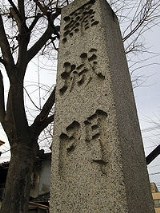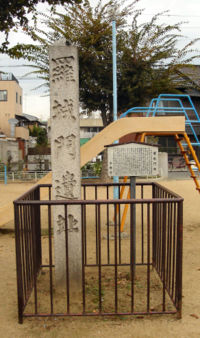
Rashomon Gate
Encyclopedia

Suzaku Avenue
is the name given to the central avenue leading to the Imperial Palace from the south in Japanese capitals. Traditionally the Imperial palace complex faces south, whilst Suzaku Avenue leads directly away from the main gate. Cities were often based on a traditional Chinese grid pattern. Suzaku...
in the ancient Japan
Japan
Japan is an island nation in East Asia. Located in the Pacific Ocean, it lies to the east of the Sea of Japan, China, North Korea, South Korea and Russia, stretching from the Sea of Okhotsk in the north to the East China Sea and Taiwan in the south...
ese cities of Heijō-kyō
Heijo-kyo
Heijō-kyō , was the capital city of Japan during most of the Nara period, from 710–40 and again from 745–84. The Palace site is a listed UNESCO World Heritage together with other places in the city of Nara Heijō-kyō (平城京, also Heizei-kyō, sometimes Nara no miyako), was the capital city of Japan...
(Nara
Nara, Nara
is the capital city of Nara Prefecture in the Kansai region of Japan. The city occupies the northern part of Nara Prefecture, directly bordering Kyoto Prefecture...
) and Heian-kyō
Heian-kyo
Heian-kyō , was one of several former names for the city now known as Kyoto. It was the capital of Japan for over one thousand years, from 794 to 1868 with an interruption in 1180....
(Kyoto
Kyoto
is a city in the central part of the island of Honshū, Japan. It has a population close to 1.5 million. Formerly the imperial capital of Japan, it is now the capital of Kyoto Prefecture, as well as a major part of the Osaka-Kobe-Kyoto metropolitan area.-History:...
), in accordance with the Chinese grid-patterned city layout. At the other far north-end of Suzaku Avenue, one would reach the Suzakumon Gate, the main entrance to the palace zone. As of 2007, the southern end of Suzaku Avenue and the possible remainder of the equivalent gate in Fujiwara-kyō
Fujiwara-kyo
was the Imperial capital of Japan for sixteen years, between 694 and 710. It was located in Yamato Province , having been moved from nearby Asuka. However, in the Nihon Shoki, the name Fujiwara-kyō had never been used...
(Kashihara
Kashihara, Nara
is a city located in Nara, Japan. It is the second largest city in the prefecture.As of January 1, 2010, the city has an estimated population of 125,547 and the density of 3,176.79 persons per km². The total area is 39.52 km²....
) are yet to be discovered.
The gate's name in modern Japanese is Rajōmon. Rajō (羅城) refers to city walls and mon (門) means "gate," so Rajōmon signifies the main city gate. Originally, this gate was known as Raseimon or Raiseimon, using alternate readings for the kanji
Kanji
Kanji are the adopted logographic Chinese characters hanzi that are used in the modern Japanese writing system along with hiragana , katakana , Indo Arabic numerals, and the occasional use of the Latin alphabet...
in the name. The name Rashōmon, using the kanji 羅生門 (which can also be read Raseimon), was popularized by a noh
Noh
, or - derived from the Sino-Japanese word for "skill" or "talent" - is a major form of classical Japanese musical drama that has been performed since the 14th century. Many characters are masked, with men playing male and female roles. Traditionally, a Noh "performance day" lasts all day and...
play of the same title, written by Kanze Nobumitsu
Kanze Nobumitsu
Kanze Kojiro Nobumitsu 観世小次郎信光 was a Japanese noh playwright and secondary actor during the Muromachi Era, from the house of Kanze. He was the grandson of Noh playwright Zeami Motokiyo, and is considered one of the last important playwrights of the golden age of Noh.-Selected plays:* Ataka*...
(1435–1516).
The modern name, Rajōmon, uses the original kanji (羅城門 rather than 羅生門) and employs what is now the more common reading for the second character (jō instead of sei).
Rashōmon in Kyoto (Heian-kyō)


Heian period
The is the last division of classical Japanese history, running from 794 to 1185. The period is named after the capital city of Heian-kyō, or modern Kyōto. It is the period in Japanese history when Buddhism, Taoism and other Chinese influences were at their height...
(794–1185). Built in 789, it was 106 feet (32.3 m) wide by 26 feet (7.9 m) high, with a 75 feet (22.9 m) stone wall and topped by a ridge-pole. By the 12th century it had fallen into disrepair and had become an unsavory place, with a reputation as a hideout for thieves and other disreputable characters. People would abandon corpses and unwanted babies at the gate.
The ruined gate is the central setting — and provides the title — for Ryūnosuke Akutagawa
Ryunosuke Akutagawa
was a Japanese writer active in the Taishō period in Japan. He is regarded as the "Father of the Japanese short story". He committed suicide at age of 35 through an overdose of barbital.-Early life:...
's short story Rashōmon
Rashomon (short story)
is a short story by Ryūnosuke Akutagawa based on tales from the Konjaku Monogatarishū.The story was first published in 1915 in Teikoku Bungaku. Akira Kurosawa's film Rashomon , takes only its name and some of the material for the frame scenes, such as the theft of a kimono and the discussion of the...
and hence for Akira Kurosawa
Akira Kurosawa
was a Japanese film director, producer, screenwriter and editor. Regarded as one of the most important and influential filmmakers in the history of cinema, Kurosawa directed 30 filmsIn 1946, Kurosawa co-directed, with Hideo Sekigawa and Kajiro Yamamoto, the feature Those Who Make Tomorrow ;...
's 1950 film
Rashomon (film)
The bandit's storyTajōmaru, a notorious brigand , claims that he tricked the samurai to step off the mountain trail with him and look at a cache of ancient swords he discovered. In the grove he tied the samurai to a tree, then brought the woman there. She initially tried to defend herself with a...
. Akutagawa's use of the gate was deliberately symbolic, with the gate's ruined state representing the moral and physical decay of Japanese civilization and culture. According to one legend, it was even inhabited by the demon Ibaraki Dōji.
Today, not even a foundation stone of the gate remains. A stone pillar marks the place where it once stood, behind a nondescript shop on Kujō street, west of Route 1
Route 1 (Japan)
National Route 1 is a major highway on the island of Honshū in Japan. It connects Chūō, Tokyo in the Kantō region with the city of Osaka, Osaka Prefecture in the Kansai region, passing through the Chūbu region en route. It follows the old Tōkaidō westward from Tokyo to Kyoto, and the old Kyo Kaidō...
within walking distance from the Heian-period temple Tō-ji
To-ji
is a Buddhist temple of the Shingon sect in Kyoto, Japan. Its name means East Temple, and it once had a partner, Sai-ji . They stood alongside the Rashomon, the gate to the Heian capital. It is formally known as which indicates that it previously functioned as a temple providing protection for the...
. A wooden sign written in Japanese and English explains the history and significance of the gate. The site sits directly next to a small playground. Though a nearby bus stop is named Rajōmon, those unfamiliar with the area are likely to miss the Rashōmon site.
Rajōmon in Nara (Heijo-kyō)
The Rajōmon in Nara stood about 4 km south to the Suzakumon of Heijō PalaceHeijo Palace
' in Nara, was the Imperial Palace of Japan , during most of the Nara period. The Palace was located in the north end of the capital city, Heijō-kyō...
. Their foundation stones were found in the excavations conducted between 1969 and 1972. From the remaining foundations, the width of the gate is estimated to have been 41.5 m.
Some of the foundation stones were reused in the 16th century by Toyotomi Hidenaga
Toyotomi Hidenaga
, formerly known as was a half-brother of Toyotomi Hideyoshi, one of the most powerful warlords of Japan's Sengoku period. He was also known by his court title, . After participating in and helping Hideyoshi win the battle at Kii, Hidenaga oversaw the construction of Wakayama Castle in 1585,...
, who was expanding his castle in Kōriyama
Yamatokoriyama, Nara
is a city located in Nara, Japan.As of August 31, 2006, the city has an estimated population of 93,280 and the density of 2,185.56 persons per km². The total area is 42.68 km².-Geography:...
.

